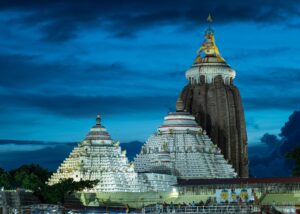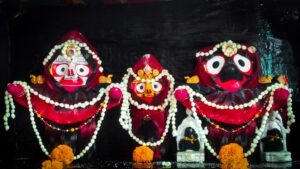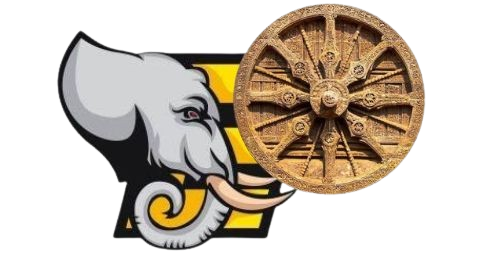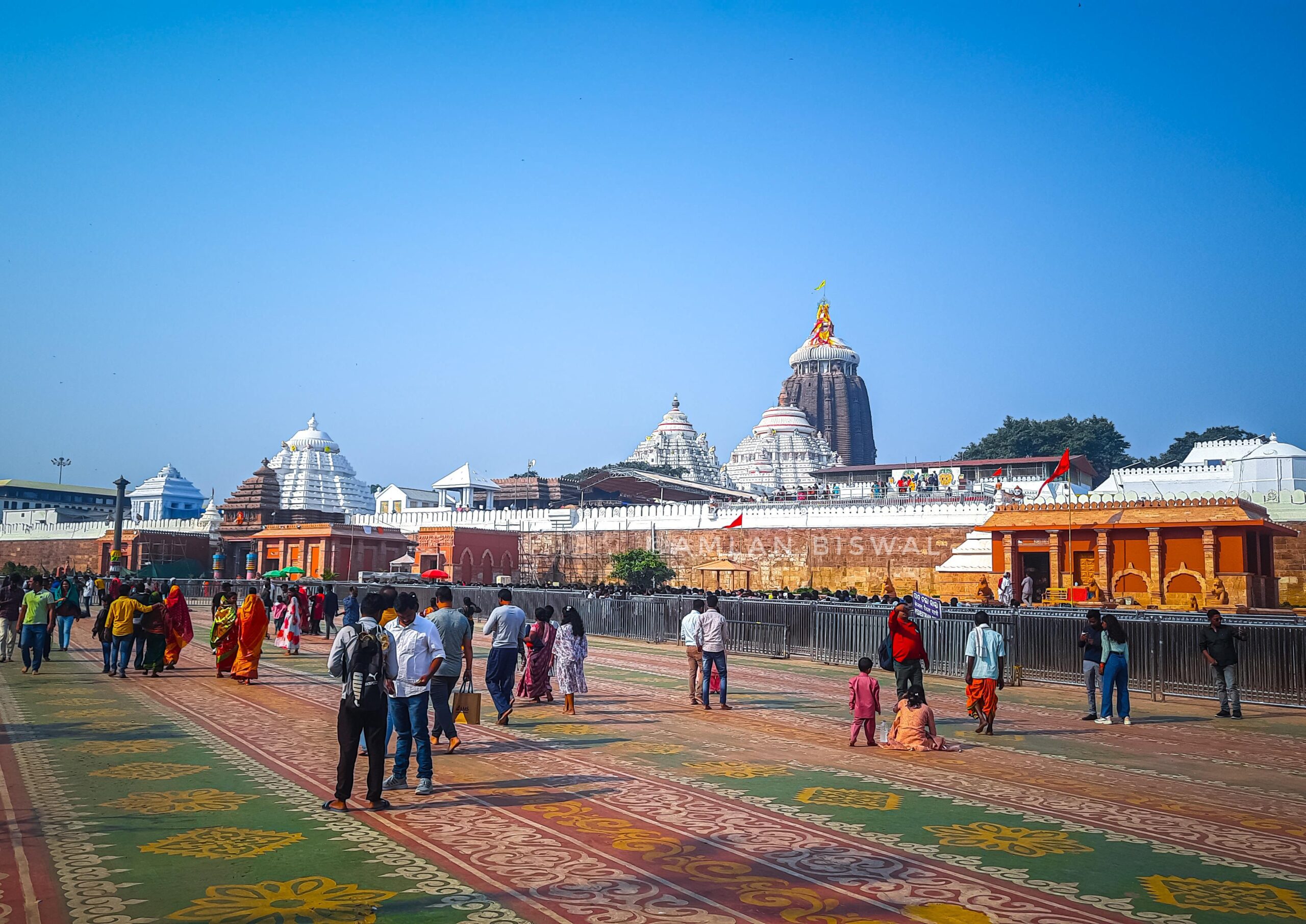The myth of Lord Jagannath’s transformation from Nila Madhava is one of the most mystical and sacred tales in Hindu mythology. It is closely associated with the Puri Jagannath Temple, which is one of the four holy Char Dham pilgrimage centers in India. The tale is referred to in several Puranas, such as the Skanda Purana, Brahma Purana, and Utkala Khanda.

—
1. The Divine Prophecy and King Indradyumna’s Quest
During Satya Yuga, Malwa King Indradyumna of present-day Madhya Pradesh was a pious follower of Lord Vishnu. He came to know about a blue-coloured mysterious god named Nila Madhava (i.e., “Blue Krishna”) secretly worshipped by a tribal chief named Vishvavasu in a dense forest.
The king longed to have darshan (sacred vision) of this deity and ordered his most trusted priests and ministers to search for Nila Madhava. However, after months of searching, none could locate the deity.
Frustrated but determined, the king sent Vidyapati, a Brahmin priest, on this divine mission.
—
2. Vidyapati’s Journey and Discovery of Nila Madhava
Vidyapati roamed about in jungles and villages until he arrived at Utkal (contemporary Odisha). There, he learned of a tribal king, Vishvavasu, who had been worshiping an enigmatic god in a secret cave far within the jungle.
Vidyapati had an encounter with Vishvavasu but was denied entry to view Nila Madhava. Destiny worked differently, however, when Vidyapati wed Vishvavasu’s daughter, Lalita. When time went on, Lalita, observing how devoted her husband was, influenced her father to bring him along to the god.
The Sly Trick
While preparing for the journey, Vidyapati secretly brought some mustard seeds along and scattered them on the trail as they were traveling to track the path back to Nila Madhava.
When he arrived at the cave, Vidyapati was besieged by the divine presence of Nila Madhava, who was resplendent with brilliant gems and ever-present self-manifesting food offerings (Mahaprasad).
Vidyapati rushed back to tell King Indradyumna, who forthwith marched with his army to take Nila Madhava to his capital.
—
3. The Disappearance of Nila Madhava
When King Indradyumna arrived at the spot, Nila Madhava had vanished mysteriously!
Stunned and grief-stricken, the king plunged into deep contemplation and prayed to Lord Vishnu for direction. A sudden divine voice (Akaashavani) directed him:
“O King! Do not lament. My incarnation as Nila Madhava is no more, but I shall return as Darubrahma (holy wood) on the banks of Puri. Construct a grand temple and await my advent.”
Upon hearing this, King Indradyumna set out to Puri and started building an imposing temple at the top of Nilachala Hill (the present-day city of Puri).
—
4. The Encounter with Daru Brahma (Divine Wooden Log)
A few years passed, and then one day there appeared a mammoth, light-emitting wooden log floating near the shores of Puri. The log stood out—it sported divine designs of Vishnu, such as the Shankha (conch), Chakra (discus), Gada (mace), and Padma (lotus).
But in spite of all their attempts, no one could lift the log. Even elephants and thousands of men were unsuccessful. One night, King Indradyumna dreamt that Lord Vishnu spoke to him as follows:
“Only a true-hearted devotee can lift this sacred log. Bring my devotee Vishvavasu and have him worship it.”
Next morning, Vishvavasu and Vidyapati were brought, and after offering prayers, they effortlessly lifted the log.
The king was ready now to carve the gods of Jagannath, Balabhadra, and Subhadra.
—
5. Lord Vishwakarma, the Celestial Carpenter
The king required a great sculptor to chisel the idols. A aged carpenter appeared at that time and presented himself as Ananta Maharana (an avatar of Lord Vishwakarma, the divine architect).
He accepted to chisel the deities on one condition:
“I will engrave the gods within a sealed room, and no one must disturb me for 21 days.”
The king consented, and Vishwakarma shut himself within the temple. There were sounds of chiseling for 14 days, but on the 15th day, there were no more sounds.
Out of fear and eagerness, Queen Gundicha asked the king to inquire about the progress. Indradyumna defied warning and opened the door. To his astonishment, the old carpenter had vanished, leaving three half-finished idols!
—
 6. The Half-Finished Forms of Lord Jagannath, Balabhadra, and Subhadra
6. The Half-Finished Forms of Lord Jagannath, Balabhadra, and Subhadra
The idols differed from any other god ever created:
– Jagannath (Krishna) had big round eyes, no hands, and an unfinished body.
– Balabhadra (Balarama) possessed a strong but incomplete form.
– Subhadra (Krishna’s sister) possessed an extraordinary rounded shape.
Indradyumna was devastated, but all of a sudden, a supernatural voice reassured him:
“O King! This is my sacred form. I have decided to stay in this Daru (wooden) form. Perform the holy rituals and consecrate me in your temple.”
Therefore, the king conducted Prana Pratistha (consecration) and initiated the first worship of Lord Jagannath, Balabhadra, and Subhadra.
7. The Timeless Rituals and Nabakalebara Tradition
Ever since, the images of Jagannath, Balabhadra, and Subhadra are revered in their incomplete wooden states, reflecting the imperfection of human vision of the divine.
A holy ritual known as Nabakalebara (Rebirth of the Lord) is performed every 12 to 19 years, when the wooden deities are interred, and new ones are sculpted from sacred neem wood (Daru Brahma).
—
8. Importance of the Transformation from Nila Madhava to Jagannath
-From Hidden to Universal Worship:
-Nila Madhava was secretly worshipped by Vishvavasu, but Jagannath became the “Lord of the Universe”, worshipped by millions.
– Symbol of Unity and Inclusion:
-Jagannath’s peculiar form includes all—he does not belong to any single sect but symbolizes all mankind.
– Divine Mystery:
-The incomplete idols remind us that the Lord’s real form is beyond human imagination.
—
Conclusion: Lord Jagannath’s Immortal Enigma
The journey from Nila Madhava to Jagannath is a tale of faith, divine plan, and fate. To this day, the Puri Jagannath Temple carries on this sacred lineage, rendering Lord Jagannath’s Rath Yatra one of the world’s most revered festivals.
This mythology reminds us that the divine appears in inexplicable forms, beyond mortal wisdom, but ever for the good of all.
—


